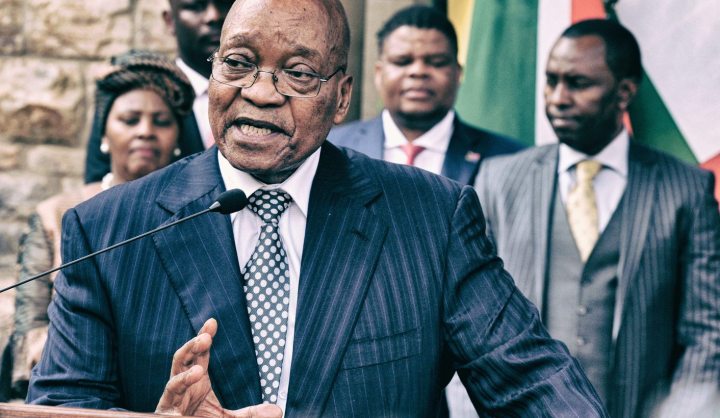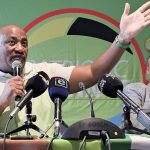South Africa
Analysis: The age of fact-free governing

It’s time to cut through the bullshit. The excruciating political noise, backed by the thump-thump threats of violence, is aimed at drowning out facts. Add into the mix the invocation of protocol and prescripts, with a dollop of “fake” news accusations against those whose views are disliked, and South Africa is in a space where doing the right thing has long been thrown out the window, in favour of rather intricate political cost-benefit calculations. By MARIANNE MERTEN.
Unity, shmunity, blah blah blah. It’s been the refrain of the ANC for years, regardless of what unfolds on the streets of Inchanga, where bullets have added a dangerous twist to political infighting, or in the council chambers of Nquthu, where opposition parties say the ANC has collapsed the council, now under administration. At Parliament where ANC MPs publicly, enthusiastically, toe the party line, but privately express misgivings. Or at Luthuli House.
And so on Wednesday the ANC announced that the (unprecedented) public expressions of unhappiness and discomfort over President Jacob Zuma’s midnight ministerial shuffle by three of the ANC’s six top officials was a “mistake”. As the official ANC statement put it: “They (the trio of officials) have further acknowledged that their public dissonance on the matter was a mistake that should not be committed again.”
With promises of the pursuit of the elusive state of unity, dismissed were vocal calls from the SACP, Cosatu, the ANC’s own veterans, civil society, business, organised labour and religious leaders for Zuma to resign, or be made to step down. As was the opposition motion of no confidence in Parliament. There was a timeous reminder, though not the first such, of the dominant attitude of the self-proclaimed leader of society by ANC Secretary-General Gwede Mantashe:
“No army allows its soldiers to be commanded by an enemy general.”
Okay then.
So the battle of the balance of forces stays within the ANC, even as it really doesn’t, with those supporting Zuma again emerging strongest.
For over a year until Friday’s reshuffle, there was sharp and sustained criticism against National Treasury and then finance minister Pravin Gordhan and his deputy Mcebisi Jonas, particularly from those regarded as being Zuma’s inner circle, like Water and Sanitation Minister Nomvula Mokonyane and Small Business Development Minister Lindiwe Zulu.
Both ministers complained publicly, according to the Mail & Guardian, of not receiving sufficient monies from National Treasury for their respective departments. Small Business Development received R3.9-billion for the next three months, amid money being returned to the national coffers due to underspending, although Zulu told the Mail & Guardian her department needed R5-billion.
Similarly, Mokonyane complained of lack of funding in what was described as a divided Cabinet meeting earlier this year, according to the Mail & Guardian. This came after Parliament’s Budget Office in October 2015 briefed MPs about lack of spending in the Water and Sanitation Department during that year’s Budget oversight processes.
This public commentary by ministers in a Cabinet that takes collective decisions can be regarded as part of the sustained criticism of the finance portfolio within a charged political context.
In the current hyper-drive spin, public briefings and glossy photo opportunities posing as delivery occasions, it’s important to separate facts from the BS. And here’s the context – and the facts:
Fact: The Budget is drafted in processes that include a ministers’ committee and a technical team of directors-general, over the better part of a year. From June every year departments submit their wish lists. There are checks on previous spending and measurements against forward going departmental strategic and performance plans. Cabinet is kept in the loop and ultimately approves the Budget before it is publicly presented in Parliament, traditionally on the last Wednesday of February.
Amid the ructions over Zuma’s reshuffle, from the plummeting rand, S&P’s downgrading to junk of a significant portion of debt and ongoing opposition from civil society to the reshuffle, eventually two government messages emerged: that of welcoming the new ministers and that while changes in the finance portfolio were made, these did not indicate changes to overall fiscal policy.
New Finance Minister Malusi Gigaba and President Jacob Zuma, in their respective public statements on Saturday and at Tuesday’s locomotive launch, used the same phrasing, cut-and-paste: “Government has been, and will remain, committed to a measured fiscal consolidation that stabilises the rise in public debt.”
Fact: A process is now unfolding in government to determine whether any adjustments in Budget allocations are needed. Traditionally these adjustments are announced in late October as the Medium-Term Budget Policy Statement (MTBPS), which also signals government’s spending priorities to be concretised in next year’s Budget.
In other words, Gigaba is now in a position to have a fundamental say in how the national purse is spent. In February Gordhan and Jonas indicated it would only be determined later this year if, and how much, of a bailout would be given to SAA – chaired by Dudu Miyeni who is also the executive chairperson of the Jacob Zuma Foundation – or Eskom. Both state-owned entities are under financial and governance pressures.
The public messaging by both the president and finance minister had to be refined from the weekend, not only because of the continuing negative impact on South Africa’s economy, which the South African Reserve Bank recently indicated would only grow 0.3%, but also the ongoing calls for Zuma to resign.
The president on Tuesday said that “while the political leadership has changed, government’s overall policy orientation remains the same as derived from the governing party, the ANC”. Although on Saturday Gigaba pledged to “focus sharply on the task of implementing the policies of the ANC…”, he had moved closer to the presidential phrasing by Tuesday:
“While the executive leadership of the finance portfolio has changed, government’s overall policy orientation remains the same.”
Fact: During his State of the Nation Address, Zuma introduced radical socio-economic transformation, which he defined in a cut-and-paste lifted from the statement on the preceding ANC lekgotla as “… fundamental change in the structure, systems, institutions and patterns of ownership, management and control of the economy in favour of all South Africans, especially the poor, the majority of whom are African and female…”
And this has continued to be his leitmotif, be it in addressing the National House of Traditional leaders or at Tuesday’s Trans-Africa locomotive launch. “We have also stated that we need to refocus and reprioritise in order to radically transform our economy, as decided by the governing party in 2012. We thus remain firm in our call that the economy needs to include the black majority in the ownership and control, so that we can have sustainability into the future,” the president said.
One day into the job, Gigaba talked of the need for radical economic transformation and National Treasury’s place therein: “For too long, there has been a narrative or perception around Treasury that it belongs primarily and exclusively to ‘orthodox’ economists, big business, powerful interests and international investors.” And he said, twice, that government would use its R500-billion procurement budget for black economic empowerment.
That tone had changed by Tuesday. “I would like to reassure you that the fiscal trajectory our country has been pursuing – which I have been party to as a member of the National Executive – will continue. Our fiscal objectives remain unchanged, as set out in the 2017 MTEF (Medium-Term Expenditure Framework),” said Gigaba.
The ANC on Wednesday shut down disagreement with Zuma and the way he does his job either as party president or the president of the country. This came a day after Zuma at Tuesday’s locomotive launch gave the first hint of what was to come. (Admission: hindsight is always 20-20.)
“We know that public statements which indicate disagreements within government by ministers, for example, demoralise our people and create confusion. This is a serious weakness and we shall attend to it within renewed vigour,” said Zuma.
Government through its official Twitter account @GovernmentZA, operated by Government Communication and Information Systems (GCIS) in Pretoria, had already tweeted such sentiments on Monday evening. “The social media messages are sent to disturb the economy and to create the impression of disorder and fear in communities,” said its Twitter timeline, and: “The social media messages are set to bring the image of SA into disrepute.”
“These illegal protests do not possess the characteristics of strengthening democracy,” it said in reference to the protest marches planned for Friday even though the process of permission application was still under way. “Those found guilty of any form of violence will face the might of the law,” added @GovernmentZA, also tweeting: “Whilst the public has a democratic right to embark on protest action, government does not support acts of civil disobedience.”
Fact: Section 17 of the Constitution states: “Everyone has the right, peacefully and unarmed, to assemble, to demonstrate, to picket and to present petitions”. Section 19 states: “Every citizen is free to make political choices, which include the right… to campaign for a political party or cause”. Section 16 of the Constitution bans propaganda for war, incitement of imminent violence and advocacy of hatred based on race, ethnicity, gender or religion but states: “Everyone has the right to freedom of expression, which includes… freedom to receive or impart information or ideas…”
It remains unclear who gave instructions for Monday’s series of tweets by @GovernmentZA, “the official South Africa Government account, offering easy access to public information and services”. By Tuesday it was back to assinine tweets like “Good morning South Africa. We wish you a productive day” and the posting of photos of and comments by ministers, deputy ministers and the president, or government leaders in GCIS-speak.
But even as @GovernmentZA posted visuals and comments from newly appointed Police Minister Fikile Mbalula at an SAPS welcoming parade on Tuesday in Pretoria – including some of the ministerial tweets – the official government Twitter account shied away from Mbalula’s #WanyaTsotsi!, which roughly translates as “Shit yourself, Tsotsi”.
The ANC closed ranks. Government has closed ranks. The bullshit factor, including the distraction of carefully orchestrated photo opportunities to announce delivery projects, is set to escalate. Beware! DM
Photo: President Jacob Zuma and Central African Republic President, His Excellency Professor Faustin-Archange Touadera (not in picture) addressing the media at the Sefako Makgatho Presidential Guesthouse in Pretoria. 05/04/2017, Kopano Tlape, GCIS


















 Become an Insider
Become an Insider